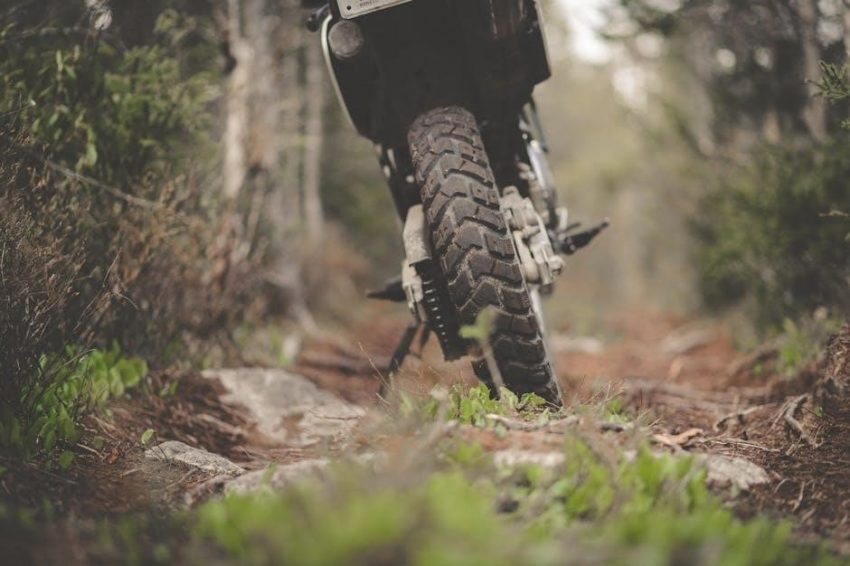Choosing the right dirt bike tire size is crucial for optimal performance, safety, and handling. This guide helps riders select tires that match their bike model, riding style, and terrain, ensuring compatibility and enhanced durability. Whether you’re racing or trail riding, proper tire size ensures better traction, stability, and control. Learn how to decode tire size codes, understand key factors influencing tire choice, and discover expert tips for maintaining your tires. This comprehensive guide is your go-to resource for making informed decisions about your dirt bike tires.
Importance of Proper Tire Size for Dirt Bikes
Proper tire size is essential for dirt bike performance, safety, and handling. Incorrect tire size can lead to poor traction, reduced stability, and increased risk of accidents. It ensures compatibility with the bike’s suspension, frame, and rims, optimizing control and responsiveness. Properly sized tires also enhance acceleration, braking, and maneuverability, making them critical for both casual and competitive riding. Incorrect sizes can cause uneven wear, reduced grip, or even damage to the bike. Always prioritize accurate tire size for a safer, more enjoyable ride.
Overview of Tire Size Codes and Measurements
Tire size codes and measurements are standardized to ensure compatibility and performance. Codes typically include the tire’s width, diameter, sidewall ratio, and load index. For dirt bikes, sizes are often expressed in inches or millimeters, with specific designations for front and rear wheels. Understanding these measurements is crucial for selecting tires that fit your bike’s rims and suspension. Proper sizing ensures optimal traction, stability, and handling. Always refer to manufacturer specifications to avoid mismatches. Accurate tire size is key to safety and performance, whether racing or trail riding.

Understanding Dirt Bike Tire Size Codes
Dirt bike tire size codes provide essential measurements, including width, diameter, and sidewall ratio, ensuring compatibility and optimal performance for specific riding conditions and bike models.
How to Read Tire Size Codes
Dirt bike tire size codes are typically formatted as 110/90-16, where 110 is the width, 90 is the aspect ratio, and 16 is the rim diameter. The numeric values represent millimeters, while the aspect ratio indicates the sidewall height as a percentage of the width. Some tires may include a load index (e.g., 67H) and speed rating (e.g., H for up to 130 mph). Always match the tire size to your bike’s specifications, as listed in the owner’s manual, to ensure safety and performance. Proper decoding ensures compatibility and optimal riding experience.
Metric vs. Standard Tire Sizes
Dirt bike tire sizes are categorized into Metric and Standard measurements. Metric sizes, like 110/90-16, use millimeters for width and aspect ratios, providing precise fitment. Standard sizes, such as 4.00-18, use inches and are simpler but less detailed. Metric sizes are more common globally due to their accuracy, while Standard sizes are often used in older or specific bike models. Always check your bike’s manual to determine the correct system for your dirt bike, ensuring proper compatibility and performance. The right choice depends on your bike’s specifications and manufacturer recommendations.
Why Tire Size Accuracy Matters
Accurate tire size is critical for optimal dirt bike performance, safety, and compatibility. Properly sized tires ensure better handling, stability, and traction, while incorrect sizes can lead to poor performance or even safety hazards. Incorrect tire size can cause misalignment with the bike’s suspension and frame, affecting control and responsiveness. Additionally, mismatched tires may void warranties or lead to mechanical issues. Ensuring the correct tire size maximizes your bike’s potential and protects your investment. Always double-check specifications to maintain safety and performance on the trail or track.
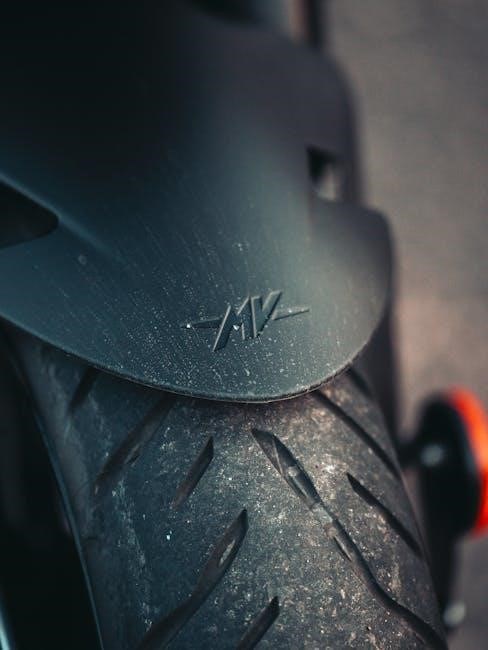
Factors Influencing Dirt Bike Tire Size
Bike model, riding style, terrain, load capacity, and modifications are key factors influencing tire size. Proper size ensures safety, performance, and compatibility with the bike and rider needs.
Bike Model and Make
The specific dirt bike model and make are critical in determining the correct tire size. Each bike manufacturer specifies recommended tire sizes in the owner’s manual, ensuring compatibility with the wheels, suspension, and overall design. Using tires that don’t match the manufacturer’s specifications can lead to poor performance, reduced safety, and potential damage to the bike. Always refer to the manual or consult a tire size chart to ensure the chosen tires align perfectly with your dirt bike’s requirements for optimal performance and durability.
Riding Style and Preferences
Riding style significantly influences dirt bike tire size and type. Aggressive riders may prefer tires with aggressive tread patterns for better grip, while casual riders might opt for smoother, more durable options. Racing bikes often require lightweight, high-traction tires, whereas trail bikes benefit from versatile, all-terrain designs. Personal preferences, such as tire width and profile, also play a role. Matching tire characteristics to your riding style ensures improved performance, handling, and overall riding satisfaction. Always consider how and where you ride when selecting tires for your dirt bike.
Terrain and Conditions
Terrain and riding conditions are critical factors in selecting the right dirt bike tires. Different environments require specific tread patterns and tire designs. For instance, soft or muddy terrains demand aggressive tread for maximum grip, while hardpack surfaces benefit from less aggressive patterns for stability and speed. Tire width and diameter also vary based on terrain, with wider tires offering better flotation in sand or mud and narrower tires excelling on tight, rocky trails. Ensuring your tires match the terrain enhances traction, control, and overall performance, making your rides safer and more enjoyable.
Load Capacity and Weight Limits
Load capacity and weight limits are essential considerations when selecting dirt bike tires. The tires must support the combined weight of the bike, rider, and any additional load. Exceeding the recommended weight limits can lead to reduced performance, poor handling, and increased risk of tire failure. Always check the tire’s load rating, typically found in the owner’s manual or on the tire’s sidewall. Selecting tires with appropriate weight limits ensures safety, optimal performance, and longer tire life. Properly matching the tires to your bike’s specifications is crucial for reliability and control on various terrains.

Types of Dirt Bike Tires
Dirt bike tires vary by type, including motocross, trail, enduro, and sand tires, each designed for specific riding conditions and performance needs. Choose the right type for your terrain.
Different Tread Patterns and Their Uses
Dirt bike tires feature various tread patterns designed for specific terrains and riding styles. Motocross tires have aggressive lug patterns for maximum grip on soft tracks, while trail tires offer moderate tread for versatile off-road conditions. Sand tires feature paddle-like treads to maintain traction in loose dunes, and hardpacked tires have smaller, tightly spaced lugs for stability on firm surfaces. Each tread design enhances performance in its intended environment, ensuring optimal grip, control, and durability. Choosing the right tread pattern is essential for maximizing your bike’s potential and ensuring safety on the terrain you ride most.
Tire Construction Types
Dirt bike tires are constructed with varying materials and designs to suit different riding demands. Common types include 2-ply, 4-ply, and 6-ply tires, with higher ply ratings offering greater durability and puncture resistance. Tire compounds also vary, with softer compounds providing better grip on soft terrain and harder compounds lasting longer on harder surfaces. Reinforced sidewalls and bead designs enhance stability and prevent tire roll during sharp turns. Each construction type is tailored to specific riding styles, ensuring optimal performance, durability, and safety for off-road adventures.
Specialized Tires for Specific Riding Needs
Dirt bike tires are tailored for distinct riding conditions and preferences. Motocross tires feature aggressive tread patterns for maximum grip on soft tracks, while enduro tires balance durability and versatility for mixed terrain. Sand tires, with their unique paddle-like designs, excel in loose conditions, providing exceptional traction. Additionally, supermoto tires are designed for paved surfaces, offering precision and speed. Each specialized tire is engineered to meet the demands of its intended environment, ensuring riders can optimize performance, safety, and control in their chosen riding style or terrain.
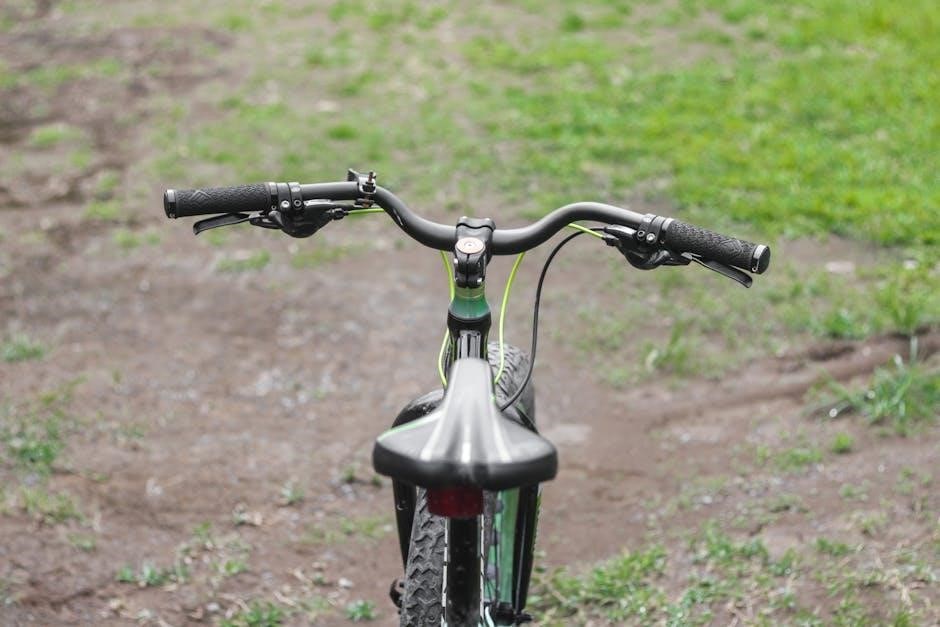
How to Choose the Right Dirt Bike Tire Size
Selecting the right dirt bike tire size involves measuring your current tires, consulting your bike’s manual, and using a tire size chart to ensure compatibility and optimal performance.
Measuring Your Current Tires
Measuring your dirt bike tires accurately is essential for selecting the right size. Start by ensuring the tires are inflated to the recommended pressure. Use a tape measure to record the diameter from the ground to the top of the tire and the width across the tread. Note the measurements carefully to avoid errors. If unsure, compare your findings with the specifications in your owner’s manual or consult a tire size chart for confirmation. Accurate measurements ensure proper fitment and optimal performance for your bike.
Checking the Owner’s Manual
Consulting your dirt bike’s owner’s manual is a crucial step in determining the correct tire size. The manual provides specific recommendations for front and rear tires, ensuring compatibility with your bike’s make and model. It also outlines load ratings and inflation pressures, which are essential for safety and performance. Always verify the information in the manual to avoid mismatches. If your bike has been modified, double-check the manual or contact the manufacturer for updated specifications. This ensures your tires meet the bike’s operational requirements and enhances overall riding safety.
Consulting a Tire Size Chart
A tire size chart is an essential tool for selecting the correct tires for your dirt bike. These charts provide detailed measurements, including width, diameter, and load ratings, ensuring compatibility with your bike’s specifications. They often categorize tires by bike type, such as motocross or trail bikes, and by terrain, like sand, mud, or hardpack. By referencing a tire size chart, you can quickly identify suitable options that match your riding style and conditions. Always cross-check with your owner’s manual to ensure accuracy, especially for modified bikes.
Common Mistakes to Avoid
When selecting dirt bike tires, common mistakes include ignoring the owner’s manual recommendations, not considering riding style or terrain, and overlooking load capacity. Riders often choose tires based on brand reputation rather than specific needs. Misjudging compatibility with wheels and suspension can lead to poor fitment. Avoiding these errors ensures optimal performance, safety, and tire longevity. Always verify measurements and consult a size chart to prevent sizing mismatches. Proper selection enhances handling, traction, and overall riding experience, making it crucial to avoid these pitfalls for the best results on and off the track.
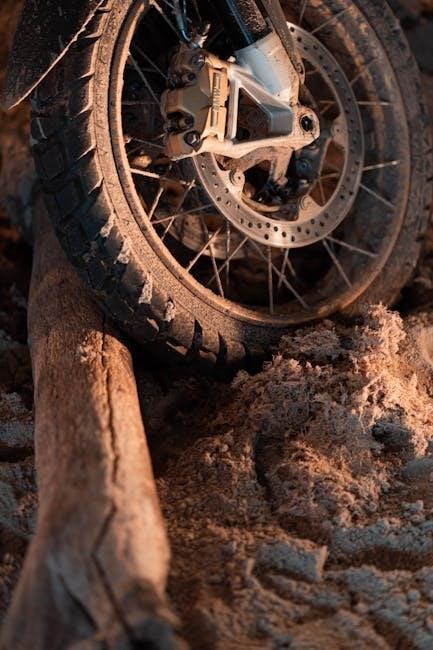
Dirt Bike Tire Size Compatibility
Ensuring tire compatibility involves checking wheel and rim fitment, frame clearance, and adjusting size after bike modifications for proper performance and safety.
Wheel and Rim Compatibility
Ensuring your dirt bike tires are compatible with your wheels and rims is essential for safety and performance. The tire’s bead must fit securely on the rim, and the rim size must match the tire’s specifications. Always check the owner’s manual or a tire size chart for precise measurements. Proper fitment prevents issues like wobbling or loss of control. Measure the rim diameter, width, and hub size to confirm compatibility. Incorrect sizing can lead to poor handling or even tire failure, making it critical to verify before installation or riding;
Frame and Suspension Clearance
Frame and suspension clearance are critical when selecting dirt bike tires to ensure proper fitment and avoid interference. The tire must have enough space to move without rubbing against the frame or suspension components, especially during compression. Measure the clearance at full suspension compression and rebound to confirm the tire size fits within the bike’s geometry. Improper clearance can lead to reduced performance, damaged components, or even safety hazards. Always refer to the manufacturer’s specifications and consider modifications if upgrading to larger or wider tires.
Adjusting Tire Size for Modifications
Modifying your dirt bike often requires adjusting tire size to maintain performance and safety. Upgrades like lift kits, wider rims, or suspension changes can alter the bike’s geometry, necessitating larger or smaller tires. Always consult a tire size chart and consider professional advice when making adjustments. Incorrect tire size can lead to poor handling, reduced stability, or even damage to the bike. Ensure modifications are compatible with the frame and suspension clearance to avoid interference and maintain optimal performance.
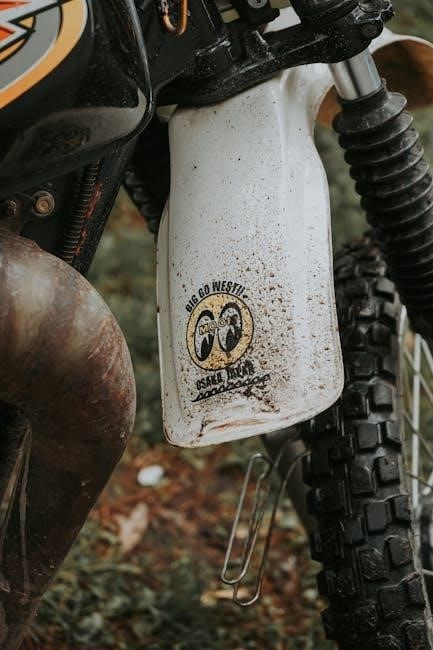
Dirt Bike Tire Size Chart
A dirt bike tire size chart provides a comprehensive reference for selecting the right tires based on bike type, riding style, and terrain, ensuring optimal performance and safety.
Size Chart by Bike Type
A size chart by bike type categorizes tires based on the specific dirt bike model, such as motocross, enduro, or trail bikes. It lists recommended tire sizes, considering factors like rim diameter, tread pattern, and load capacity. For example, a Honda CRF450R might use a 90/90-21 front tire and 120/80-19 rear, while a Yamaha YZ250F could opt for 80/100-21 front and 100/90-19 rear. This chart ensures riders select tires that align with their bike’s specifications for optimal performance, handling, and safety, regardless of the riding style or terrain.
Size Chart by Riding Style
A size chart by riding style organizes tire sizes based on how the dirt bike is used, such as racing, trail riding, or casual off-road adventures. For racing, tires might be narrower, like 90/90-21 front and 120/80-19 rear, to enhance speed and maneuverability. Trail riding often uses wider tires, such as 110/90-19 front and 140/80-17 rear, for better grip and durability on varied terrain. Casual riders might opt for all-purpose tires with sizes like 100/90-19 front and 130/80-17 rear, balancing versatility and comfort. This chart helps riders choose tires that match their riding preferences, ensuring optimal performance, safety, and enjoyment.
Size Chart by Terrain Type
A size chart by terrain type categorizes dirt bike tire sizes based on riding conditions, such as sand, mud, hardpack, or mixed environments. For soft sand, wider tires like 100/90-19 front and 110/90-18 rear provide better floatation and stability. In muddy conditions, aggressive tread patterns and sizes like 120/80-19 front and 130/80-18 rear enhance traction. Hardpack terrain often uses medium-width tires, such as 90/90-21 front and 120/70-19 rear, for precise handling. This chart ensures riders select tires that excel in their preferred terrain, optimizing grip, control, and overall performance.
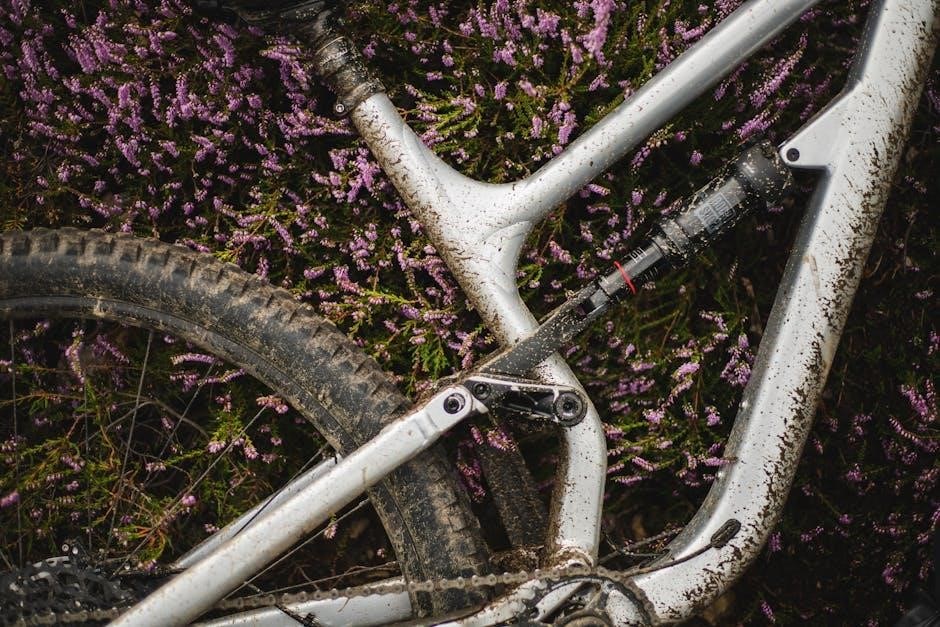
The Impact of Tire Size on Performance
Tire size significantly affects a dirt bike’s speed, acceleration, and overall ride quality. Proper sizing enhances power delivery and maneuverability, while incorrect sizes can hinder performance and stability.
Handling and Stability
Proper tire size directly impacts a dirt bike’s handling and stability. Tires that are too small or too large can compromise responsiveness and balance, affecting cornering and braking performance. A well-sized tire ensures optimal ground contact, improving maneuverability and reducing the risk of tipping. Riders can enjoy better control on various terrains, whether carving through tight trails or maintaining speed on open tracks. Incorrect tire size can lead to instability, making the bike difficult to handle, especially at higher speeds or during sharp turns. Always prioritize correct sizing for enhanced safety and performance.
Speed and Acceleration
Tire size significantly influences a dirt bike’s speed and acceleration. Larger tires can achieve higher top speeds due to their greater circumference, covering more ground per rotation. However, smaller tires often deliver quicker acceleration, as they rotate faster and generate more torque. The right tire size ensures the engine operates within its optimal RPM range, maximizing power delivery. Incorrect sizing can lead to subpar performance, either by limiting speed or hindering acceleration. Properly sized tires enhance responsiveness, allowing riders to exploit their bike’s full potential on tracks or trails. Balance is key for achieving desired speed and acceleration.
Traction and Grip
Tire size and tread pattern significantly impact traction and grip on various terrains. A larger tire with aggressive tread excels in soft or muddy conditions, providing superior grip. Smaller tires, while offering less contact area, can deliver precise handling on hard surfaces. Proper tire size ensures even weight distribution, enhancing stability. The wrong size may compromise traction, leading to loss of control. Tread design plays a crucial role, with deeper lugs for mud and shallower patterns for hardpack. Matching tire size to terrain ensures maximum grip, improving overall performance and safety for dirt bike riders. Balance is key for optimal traction.
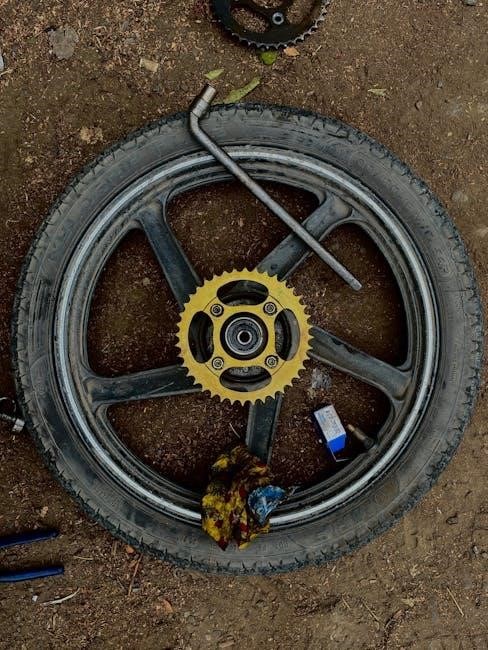
Dirt Bike Tire Maintenance and Replacement
Regular tire inspections and proper maintenance are essential for longevity. Check pressure frequently, inspect tread depth, and replace tires when worn or damaged to ensure safety and performance.
When to Replace Tires
Dirt bike tires should be replaced when the tread depth is less than 1/16 of an inch or when cracks appear on the sidewalls. Punctures that cannot be repaired also necessitate replacement. Additionally, tires should be replaced if they show signs of uneven wear, such as bald spots or excessive wear on one side. Age is another factor; tires older than five years may degrade even if they appear unused. Regular inspections and monitoring for these signs ensure safety and optimal performance on the trail or track.
How to Maintain Tire Health
Regular tire maintenance is essential for longevity and performance. Always check tire pressure before riding, adhering to the manufacturer’s recommendations. Inspect tires for punctures, cuts, or uneven wear. Clean tires with mild soap and water to remove dirt and debris. Avoid exposure to direct sunlight or extreme temperatures. Store tires in a cool, dry place when not in use. Rotate tires periodically to ensure even wear. Proper maintenance ensures safety, optimal traction, and extends the life of your dirt bike tires, enhancing overall riding experience and performance.
Signs of Worn-Out Tires
Identifying worn-out tires is crucial for safety and performance. Look for visible signs such as excessive tread wear, cracks in the rubber, or damage to the sidewalls. If the tread is worn down to the casing, it’s time for a replacement. Uneven wear patterns may indicate misalignment or improper inflation. Check for bulges, blisters, or punctures that can lead to failures. A wobbly tire or vibration during riding also signals wear. Regular inspections can prevent accidents and ensure optimal performance. Replace tires immediately if you notice any of these signs to maintain safety and control while riding.
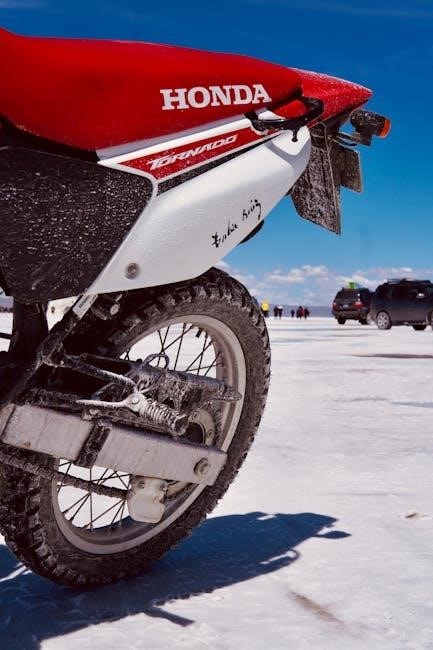
Frequently Asked Questions
Common questions about dirt bike tire size include understanding compatibility, the impact of modifications, and how to ensure safety. Riders often ask about optimal tire sizes for specific terrains and how to avoid common sizing errors. Additionally, inquiries about the relationship between tire size and performance are frequent. These questions highlight the importance of proper tire selection for both safety and enhanced riding experiences.
Common Questions About Tire Size
Common questions about dirt bike tire size often revolve around compatibility with rims, handling differences, and performance impact. Riders frequently ask how to decode tire size codes and whether larger tires always offer better performance. Many inquire about the safest tire sizes for specific terrains and how modifications might affect tire fitment. Additionally, questions arise about the relationship between tire size and speed, as well as how to avoid common sizing mistakes that could compromise safety or performance. These questions underscore the importance of precise tire selection for optimal riding experiences.
Addressing Misconceptions
Some riders believe that larger tires always improve performance, but this isn’t true. Oversized tires can increase weight and affect handling. Others think any tire fits their bike, but compatibility with rims and suspension is crucial. A common myth is that tire size doesn’t impact speed, yet it directly affects gearing and acceleration. Another misconception is that all tires are durable, but lifespan depends on terrain and usage. Understanding these myths helps riders make informed choices for optimal performance and safety.
Expert Tips for Tire Selection
Experts recommend using a tire size chart to ensure accurate fitment for your bike model. Always check compatibility with rims and suspension to avoid performance issues. Match tread patterns to your riding terrain for better grip and control. Regularly inspect tires for wear and damage, and maintain proper pressure for optimal performance. Consider consulting a mechanic for custom modifications. Remember, the right tires enhance safety, durability, and overall riding experience, so prioritize quality and compatibility when making your selection.
Selecting the right dirt bike tire size ensures safety, performance, and compatibility. Always prioritize proper fitment, match tires to your riding style, and maintain them regularly for optimal results.
Final Thoughts on Choosing the Right Tire Size
Choosing the right dirt bike tire size is a critical decision that impacts performance, safety, and overall riding experience. Always prioritize proper fitment, ensuring compatibility with your bike’s make and model. Consider factors like terrain, riding style, and load capacity to make an informed choice. Refer to tire size charts and consult the owner’s manual for guidance. Maintaining tires regularly and replacing them when necessary ensures optimal traction, stability, and control. Remember, the right tire size enhances your bike’s handling and guarantees a safer, more enjoyable ride.
Encouragement to Prioritize Tire Safety
Prioritizing tire safety is essential for every dirt bike rider. Always inspect tires before rides, checking for wear, damage, or improper inflation. Properly maintained tires enhance performance, stability, and control. Neglecting tire safety can lead to reduced traction, poor handling, and increased risk of accidents. Regular maintenance and timely replacements are crucial for a safe and enjoyable riding experience. Remember, tire safety directly impacts your well-being and the reliability of your bike. Make it a habit to prioritize tire health for every ride.
